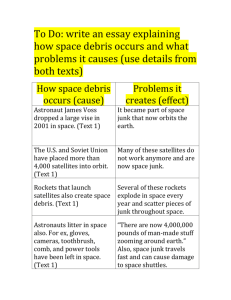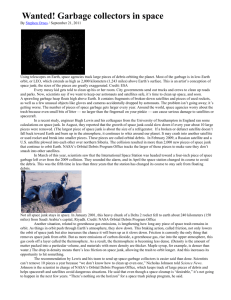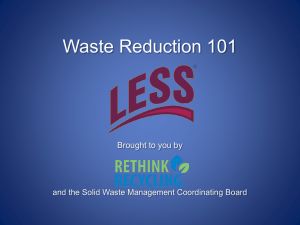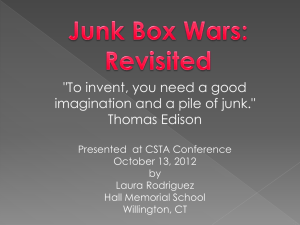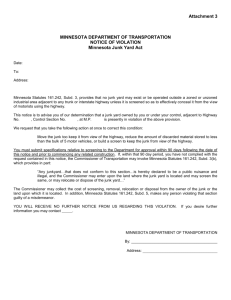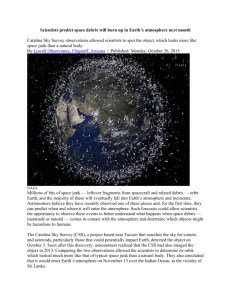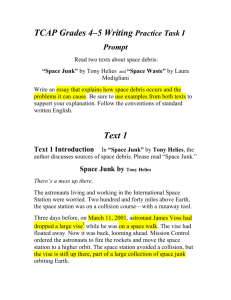What is Space Junk? B
advertisement
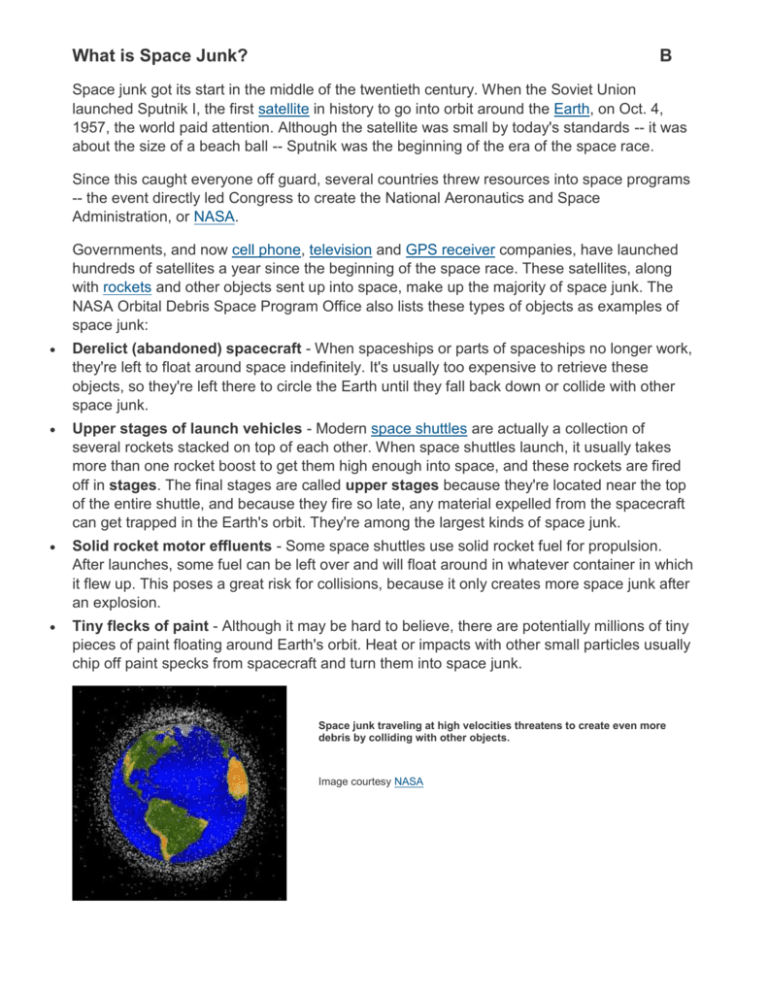
What is Space Junk? B Space junk got its start in the middle of the twentieth century. When the Soviet Union launched Sputnik I, the first satellite in history to go into orbit around the Earth, on Oct. 4, 1957, the world paid attention. Although the satellite was small by today's standards -- it was about the size of a beach ball -- Sputnik was the beginning of the era of the space race. Since this caught everyone off guard, several countries threw resources into space programs -- the event directly led Congress to create the National Aeronautics and Space Administration, or NASA. Governments, and now cell phone, television and GPS receiver companies, have launched hundreds of satellites a year since the beginning of the space race. These satellites, along with rockets and other objects sent up into space, make up the majority of space junk. The NASA Orbital Debris Space Program Office also lists these types of objects as examples of space junk: Derelict (abandoned) spacecraft - When spaceships or parts of spaceships no longer work, they're left to float around space indefinitely. It's usually too expensive to retrieve these objects, so they're left there to circle the Earth until they fall back down or collide with other space junk. Upper stages of launch vehicles - Modern space shuttles are actually a collection of several rockets stacked on top of each other. When space shuttles launch, it usually takes more than one rocket boost to get them high enough into space, and these rockets are fired off in stages. The final stages are called upper stages because they're located near the top of the entire shuttle, and because they fire so late, any material expelled from the spacecraft can get trapped in the Earth's orbit. They're among the largest kinds of space junk. Solid rocket motor effluents - Some space shuttles use solid rocket fuel for propulsion. After launches, some fuel can be left over and will float around in whatever container in which it flew up. This poses a great risk for collisions, because it only creates more space junk after an explosion. Tiny flecks of paint - Although it may be hard to believe, there are potentially millions of tiny pieces of paint floating around Earth's orbit. Heat or impacts with other small particles usually chip off paint specks from spacecraft and turn them into space junk. Space junk traveling at high velocities threatens to create even more debris by colliding with other objects. Image courtesy NASA The Dangers of Space Junk The U.S. Space Surveillance Network, a department that tracks debris floating through space and reports to NASA, observes over 13,000 man-made objects orbiting Earth larger than 4 inches in diameter [source: National Geographic News]. That number has only been increasing, up from 9,000 objects in 2000. The organization estimates there are also millions of much smaller objects floating around, and all of it combined weighs about 5,500 tons. Does all this space junk create any problems for space stations -- or even people on the ground? Although it's hard to believe, many of these objects travel around the Earth at speeds more than 22,000 miles an hour. Anything traveling at a velocity this high would cause a considerable amount of damage to a spacecraft if a direct hit occurred. Even a tiny fleck of paint traveling at such a speed is capable of boring a quarter-inch hole into the window of a space station. Because there are so many objects flying around up there, there's concern that collisions between debris will only produce more fragments. Even if we stopped launching spacecraft right now and didn't send a single object into orbit, the amount of debris in space would remain constant until 2055 [source: National Geographic News]. After that, things would actually get worse, because the amount of material already up there would inevitably collide and create even more space junk. Experts are worried this is already happening. The most recent case of such a collision, for instance, happened on Jan. 17, 2005, when a piece of debris from an exploded Chinese rocket smashed into a 31-year-old American rocket that had been left alone. The collision only produced four pieces of debris, but observers fear it's only a matter of time before such pieces create an unstoppable chain reaction. The good news for astronauts is that most space junk is located between 550 and 625 miles above the Earth -- the International Space Station flies in orbit at 250 miles high, while space shuttles usually only reach 375 miles above Earth. Space programs are also working on rocket designs that limit the amount of debris created during a launch. For those of us on Earth, is there a possibility space junk could fall back to the ground? Everything in orbit will eventually be pulled back down by Earth's gravity -- when that happens depends on how high the object is and how fast it's going. The higher the altitude, the longer the object will take to fall, and it'll take even longer the faster it's speeding around the Earth. These objects could stay in orbit for thousands of years. And the risks of getting hit on the head? Fortunately, most debris burns up during reentry, and no one has ever been killed by space junk -- UK bookmakers note the chances of space junk landing on a person are at least 20 billion to one [source: The Scotsman].
